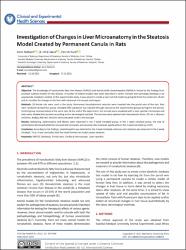Investigation of changes in liver microanatomy in the steatosis model created by permanent canula in rats

Göster/
Erişim
info:eu-repo/semantics/openAccessAttribution-NonCommercial 4.0 Internationalhttps://creativecommons.org/licenses/by-nc/4.0/Tarih
2022Üst veri
Tüm öğe kaydını gösterKünye
Nalbant, A., Şakul, B. U. ve Yücel, F. (2022). Investigation of changes in liver microanatomy in the steatosis model created by permanent canula in rats. Clinical and Experimental Health Sciences, 12(3), 659-664. https://doi.org/10.33808/clinexphealthsci.948391Özet
Objective: The knowledge of nonalcoholic fatty liver disease (NAFLD) and Nonalcoholic Steatohepatitis (NASH) is limited to the findings from available suitable models for this disease. A number of rodent models have been described in which relevant liver pathology develops in an appropriate metabolic context. In this experimental study, it was aimed to create a new liver fat model by giving fat from the portal vein of rats and to visualize the changes in the liver with advanced microscopic techniques.Methods: 28 female rats were used in the study. Permanent intraabdominal cannulas were inserted into the portal vein of the rats. Rats were randomly divided four group. Intralipid 20% substance was injected through cannula to the experimental groups during the test period. Control group received saline at the same rate. At the end of the experiment, the animals were visualized with a laser speckle microscope and livers were divided into sections according to the stereological method. The sections were painted with Hematoxylin-Eosin, Oil red o, Masson trichoma, Bodipy, Nile red. Sections were evaluated under a microscope.Results: Ballooning, inflammation and fibrosis were observed in the 2 week intralipid group. In the 1 week intralipid group, the rate of parenchyma decreased while the sinusoid rate increased, and sinusoid rate increased significantly in the 2 week intralipid (p<0.05). Conclusion: According to the findings, steatohepatitis was detected in the 2 week intralipid, whereas only steatosis was observed in the 1 week intralipid. Thus, it was concluded that the newly formed rat model causes steatosis.
Kaynak
Clinical and Experimental Health SciencesCilt
12Sayı
3Koleksiyonlar
- Makale Koleksiyonu [3770]
- TR-Dizin İndeksli Yayınlar Koleksiyonu [2177]
- WoS İndeksli Yayınlar Koleksiyonu [6621]


















